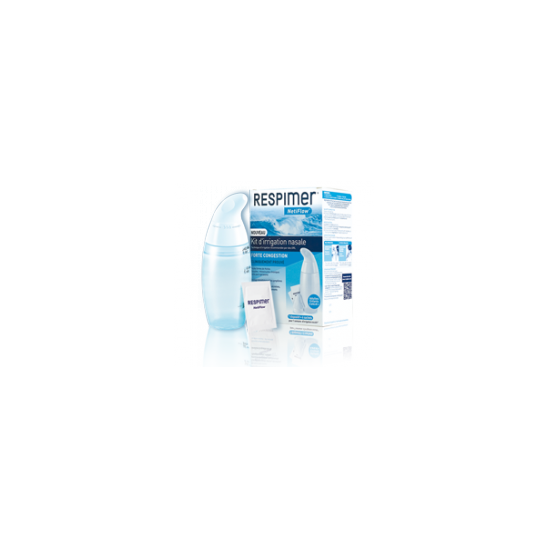



RESPIMER NetiFlow est un nouveau dispositif de lavage nasal qui consiste à irriguer les cavités rhino-sinusiennes de manière abondante et continue en vue de décongestionner, assainir et apaiser les muqueuses de l/'appareil respiratoire
RESPIMER NetiFlow procure un soulagement durable des symptômes du nez et des sinus, et une amélioration significative de la qualité de vie.
La particularité de RESPIMER NetiFlow réside dans sa formule haute tolérance (proche du liquide extracellulaire) et son dispositif qui permet de choisir entre 2 modes d/'irrigation suivant vos préférences et vos symptômes.
Respimer Netiflow : une formule UNIQUE qui contient les principaux électrolytes impliqués dans la régénération de l/'épithélium respiratoire (1-3) alors que les solutions maison à base de gros sel et les sérums physiologiques ne contiennent que du chlorure de sodium.

** Moyenne des relevés internes.
En fonction des préférences et de la sévérité des symptômes, RESPIMER Netiflow offre deux modes d/'administration :


Respimer Netiflow est un dispositif INNOVANT pour une irrigation nasale adaptée, pratique et efficace

Bibliographie
(1) Bardou O, Trinh NT, Brochiero E. Molecular diversity and function of K+ channels in airway and alveolar epithelial cells. Am J Physiol Lung Cell Mol Physiol. 2009;296(2):L145-L155.
(2) Trinh NT, Prive A, Kheir L, Bourret JC, Hijazi T, Amraei MG, Noel J, Brochiero E. Involvement of KATP and KvLQT1 K channels in EGF-stimulated alveolar epithelial cell repair processes. Am J Physiol Lung Cell Mol Physiol. 2007;293(4):L870-882.
(3) Trinh NT, Prive A, Maille E, Noel J, Brochiero E. EGF and K+channel activity control normal and cystic fibrosis bronchial epithelia repair. Am J Physiol Lung Cell Mol Physiol. 2008;295(5):L866-80.
(4) Ma W, Korngreen A, Uzlaner N, et al. Extracellular sodium regulates airway ciliary motility by inhibiting a P2X receptor. Nature. 1999;400(6747):894-897.
(5) Baraniuk JN, Ali M, Yuta A, et al. Hypertonic saline nasal provocation stimulates nociceptive nerves, substance P release, and glandular mucous exocytosis in normal humans. Am J Respir Crit Care Med. 1999;160(2):655-662.
(6) Marini M, Vittori E, Hollemborg J, et al. Expression of the potent inflammatory cytokines, granulocyte/macrophage colony-stimulating factor and interleukin-6, and interleukin-8, in bronchial epithelial cells of patients with asthma. J Allergy Clin Immunol. 1992;89:1001–1009.
(7) Jaovishidha P, Peeples ME, Brees AA, et al. Respiratory syncytial virus stimulates neutrophil degranulation and chemokine release. J Immunol. 1999;163:2816–2820.
(8) Levin R, Braiman A, Priel Z. Protein kinase C induced calcium influx and sustained enhancement of ciliary beating by extracellular ATP. Cell Calcium. 1997;21(2):103-113.
(9) Cordray S, Harjo JB, Miner L. Comparison of intranasal hypertonic dead sea saline spray and intranasal aqueous triamcinolone spray in seasonal allergic rhinitis. Ear Nose Throat J. 2005;84(7):426-430.
(10) Blitz M, Blitz S, Hughes R, et al. Aerosolized magnesium sulfate for acute asthma: a systematic review. Chest. 2005;128(1):337-344.
(11) Keen JH. Intravenous magnesium sulfate for acute asthma. J Emerg Nurs. 1995;21(1):44-46.
(12) Ludwig P, Petrich K, Schewe T, et al. Inhibition of eicosanoid formation in human polymorphonuclear leukocytes by high concentrations of magnesium ions. Biol Chem Hoppe Seyler. 1995;376(12):739-744.
(13) Chen EY, Yang N, Quinton PM, et al. A new role for bicarbonate in mucus formation. Am J Physiol Lung Cell Mol Physiol. 2010;299(4):L542-9.
(14) Luk CK, Dulfano MJ. Effect of pH, viscosity and ionic-strength changes on ciliary beating frequency of human bronchial explants. Clin Sci.1983;64(4):449-51.
Date de mise à jour : 29-04-2025